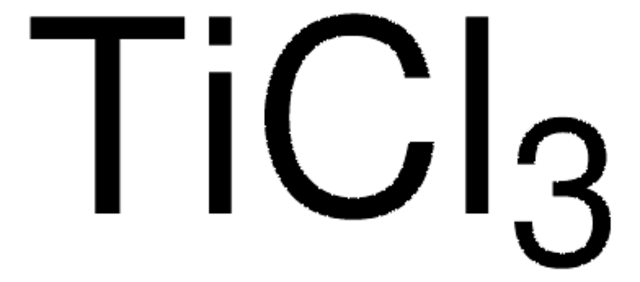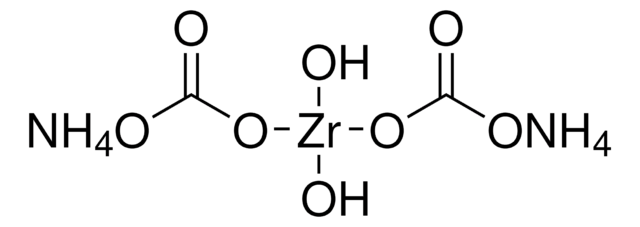Products may be shipped at a different temperature than the recommended long-term storage temperature. If the product quality is sensitive to short-term exposure to conditions other than the recommended long-term storage, it will be shipped on wet or dry-ice. If the product quality is NOT affected by short-term exposure to conditions other than the recommended long-term storage, it will be shipped at ambient temperature. As shipping routes are configured for minimum transit times, shipping at ambient temperature helps control shipping costs for our customers. For more information, please refer to the Storage and Transport Conditions document: https://www.sigmaaldrich.com/deepweb/assets/sigmaaldrich/marketing/global/documents/316/622/storage-transport-conditions-mk.pdf
Wichtige Dokumente
388165
Titan(IV)-bis(ammoniumlactato)dihydroxid -Lösung
50 wt. % in H2O
Synonym(e):
Dihydroxybis(ammonium lactato)titanium solution
Größe auswählen
Größe auswählen
About This Item
Empfohlene Produkte
Dampfdruck
0.51 psi ( 20 °C)
3.19 psi ( 55 °C)
Qualitätsniveau
Form
liquid
Eignung der Reaktion
core: titanium
reagent type: catalyst
Konzentration
50 wt. % in H2O
Brechungsindex
n20/D 1.438
Dichte
1.222 g/mL at 25 °C
SMILES String
N.N.CC(O[Ti](O)(O)OC(C)C(O)=O)C(O)=O
InChI
1S/2C3H5O3.2H3N.2H2O.Ti/c2*1-2(4)3(5)6;;;;;/h2*2H,1H3,(H,5,6);2*1H3;2*1H2;/q2*-1;;;;;+4/p-2
InChIKey
XRASGLNHKOPXQL-UHFFFAOYSA-L
Verwandte Kategorien
Anwendung
- A water-soluble Ti precursor for the synthesis of TiO2/WO3 nanofibers applicable in photocatalysis.[1]
- A reactant to synthesize a complex with pyrocatechol violet applicable as a colorimetric HF sensing dye.[2][3]
- A Ti precursor to synthesize mesoporous silica loaded with titania nanoparticles for photocatalytic applications.[4]
Signalwort
Warning
H-Sätze
Gefahreneinstufungen
Flam. Liq. 3
Lagerklassenschlüssel
3 - Flammable liquids
WGK
WGK 3
Flammpunkt (°F)
81.9 °F
Flammpunkt (°C)
27.7 °C
Hier finden Sie alle aktuellen Versionen:
Besitzen Sie dieses Produkt bereits?
In der Dokumentenbibliothek finden Sie die Dokumentation zu den Produkten, die Sie kürzlich erworben haben.
Kunden haben sich ebenfalls angesehen
-
How is shipping temperature determined? And how is it related to the product storage temperature?
1 answer-
Helpful?
-
-
How can I determine the shelf life / expiration / retest date of this product?
1 answer-
If this product has an expiration or retest date, it will be shown on the Certificate of Analysis (COA, CofA). If there is no retest or expiration date listed on the product's COA, we do not have suitable stability data to determine a shelf life. For these products, the only date on the COA will be the release date; a retest, expiration, or use-by-date will not be displayed.
For all products, we recommend handling per defined conditions as printed in our product literature and website product descriptions. We recommend that products should be routinely inspected by customers to ensure they perform as expected.
For products without retest or expiration dates, our standard warranty of 1 year from the date of shipment is applicable.
For more information, please refer to the Product Dating Information document: https://www.sigmaaldrich.com/deepweb/assets/sigmaaldrich/marketing/global/documents/449/386/product-dating-information-mk.pdfHelpful?
-
Active Filters
Unser Team von Wissenschaftlern verfügt über Erfahrung in allen Forschungsbereichen einschließlich Life Science, Materialwissenschaften, chemischer Synthese, Chromatographie, Analytik und vielen mehr..
Setzen Sie sich mit dem technischen Dienst in Verbindung.











